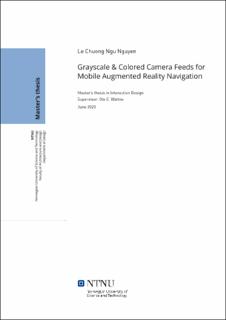Grayscale & Colored Camera Feeds for Mobile Augmented Reality Navigation
Abstract
Mobile augmented reality applications are comprised of three components: the camera feeds, the virtual objects rendered on top of such camera feeds (e.g. virtual navigation signage), and the application interface (e.g. icons, menus). While the last two components have been relatively explored, very few literatures studied the first component – the camera feeds, especially in terms of color design.
This study evaluates if rendering the camera feeds in Grayscale mode, instead of Colored mode, is effective for mobile augmented reality navigation. By having the camera feeds in Grayscale mode, the user’s visual attention is hypothesised to be towards the important elements of a mobile augmented reality navigation application - the virtual navigation signage. In addition, this study also examines the user’s satisfaction in using the Grayscale mode as compared to the Colored mode.
An experiment was conducted with two simple indoor navigation tasks performed by the research participants, one in Grayscale mode and the other in Colored mode. Effectiveness (Time Taken) and User Satisfaction (Easiness, Enjoyability) were measured. Due to the COVID-19 situation, the experiment was conducted online with research participants performing the navigation tasks on a computer. Such an approach was a deviation from the originally planned experiment which was to be conducted in person using mobile augmented reality.
The results from the study statistically suggested no significant differences between Grayscale mode and Colored mode navigation.
Keywords: camera feeds, grayscale, color, mobile augmented reality, navigation, effectiveness, user satisfaction. Mobile augmented reality applications are comprised of three components: the camera feeds, the virtual objects rendered on top of such camera feeds (e.g. virtual navigation signage), and the application interface (e.g. icons, menus). While the last two components have been relatively explored, very few literatures studied the first component – the camera feeds, especially in terms of color design.
This study evaluates if rendering the camera feeds in Grayscale mode, instead of Colored mode, is effective for mobile augmented reality navigation. By having the camera feeds in Grayscale mode, the user’s visual attention is hypothesised to be towards the important elements of a mobile augmented reality navigation application - the virtual navigation signage. In addition, this study also examines the user’s satisfaction in using the Grayscale mode as compared to the Colored mode.
An experiment was conducted with two simple indoor navigation tasks performed by the research participants, one in Grayscale mode and the other in Colored mode. Effectiveness (Time Taken) and User Satisfaction (Easiness, Enjoyability) were measured. Due to the COVID-19 situation, the experiment was conducted online with research participants performing the navigation tasks on a computer. Such an approach was a deviation from the originally planned experiment which was to be conducted in person using mobile augmented reality.
The results from the study statistically suggested no significant differences between Grayscale mode and Colored mode navigation.
Keywords: camera feeds, grayscale, color, mobile augmented reality, navigation, effectiveness, user satisfaction.
